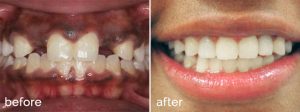After completing his tour of active duty as an Army dentist, Dr. Roger Druckman went into practice and immediately began to use implants for tooth replacement and stabilization. Implants offer the ability to replace missing teeth without the need for removable appliances or drilling down perfectly good teeth to make a bridge to replace missing teeth.
Dr. Roger Druckman uses both standard-sized implants and mini implants. Standard-sized implants vary from 3 to 6 millimeters in diameter, while mini implants vary from 1.8 to 3 millimeters in diameter. Both mini implants and standard-sized implants come in various lengths.
While you cannot use mini implants everywhere, they can be used in the majority of cases. With standard-sized implants, there are many instances in which bone grafting is required. However, with mini implants, this is not the case.
With standard-sized implants, most cases involve waiting for the implant to integrate with the patient’s bone before the crown can be placed. Typically, we have to wait 4 to 6 months for integration to occur. With mini implants, it is often possible to place the implant and cement the crown in the same visit. This is known as Teeth in a Day.
Therefore, if Dr. Roger Druckman has a patient who requires a bridge for any number of teeth, the implants typically can be placed and the bridgework cemented in the same appointment.
While it is not the standard of care to do a CT scan for every implant procedure, it is routinely done at Dr. Roger Druckman’s office for every standard-sized implant and for most of the mini implants. The mini implants placed in the anterior part of the mandible really only require an X-ray. Often times the panoramic X-ray is sufficient for the placement of mini implants in the anterior part of the mandible.
However, a CT scan is advisable for implant placement in the rest of the maxilla (upper jaw) and mandible (lower jaw). In the maxilla, Dr. Roger Druckman needs to be certain that he knows how much bone is available so that he does not place an implant into the patient’s sinus. If there is an insufficient amount of bone for an implant placement, Dr. Roger Druckman will do a sinus lift to graft bone to the patient’s natural bone. Furthermore, Dr. Roger Druckman has been trained in lateral and vertical bone grafting for ridge augmentation as well as sinus lift techniques, and employs them whenever required. After approximately 4 months, the grafted bone will have integrated with the patient’s bone and an implant may be placed. Also, depending upon the patient’s bone, it might even be possible to place the implant at the same time the bone graft is being placed. In these cases, standard-sized implants are required.
When patients have upper dentures, they often complain about their palate being covered with the plastic of the denture. They report that the palatal plastic of the upper denture even affects their ability to taste their food. Dr. Roger Druckman can stabilize upper dentures with four mini implants so that dentures adhesive is never required, but can also place 6 mini implants to provide the patient with a palate-less upper denture that is securely locked into place.
Dr. Roger Druckman’s implant expertise has been gained not just with 40 years of placing implants, but also a great many implant courses – not the least of which was a 300-hour 1-year residency in implantology at New York University College of Dentistry that culminates with his passing the board exams of the American Academy of Implant Dentistry.
If you want a perfectionist to place and restore your dental implants in Denver, Colorado, you need to see Dr. Roger Druckman. Call 303-691-2860 for a free consultation at the office of Roger Druckman, DDS PC, which includes a free panoramic X-ray.



 303-691-2860
303-691-2860